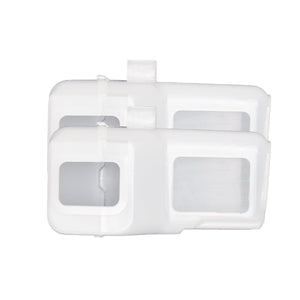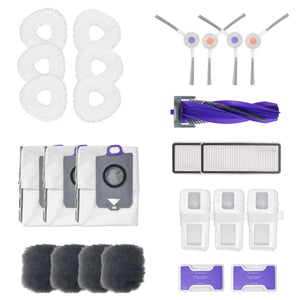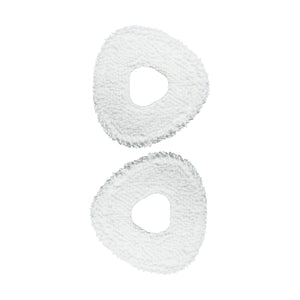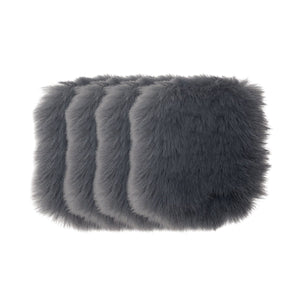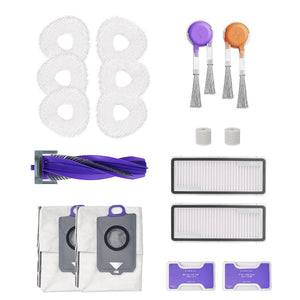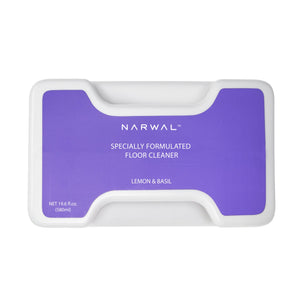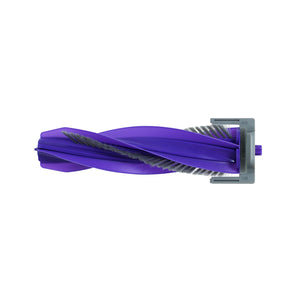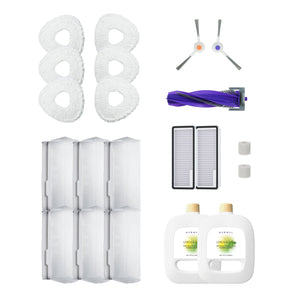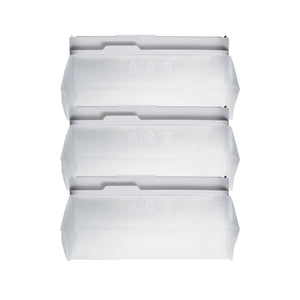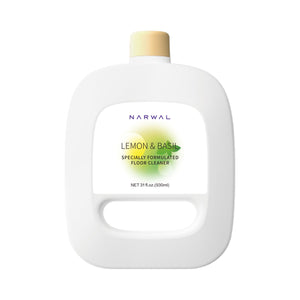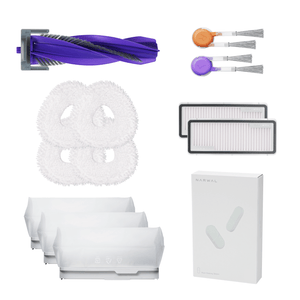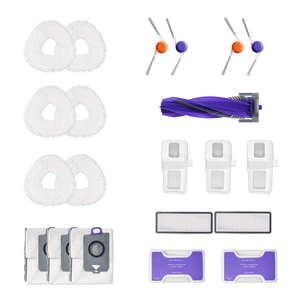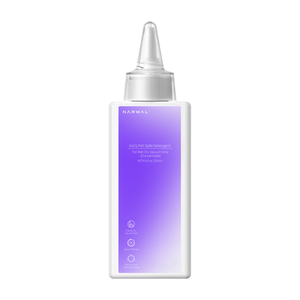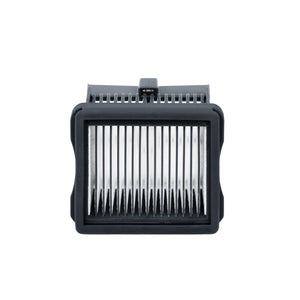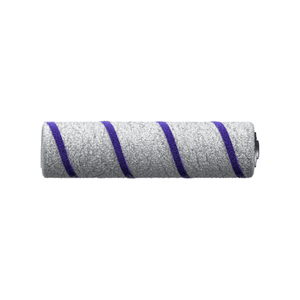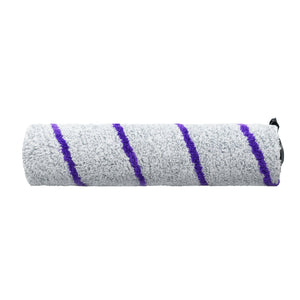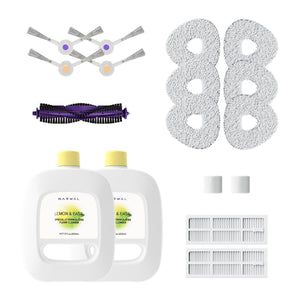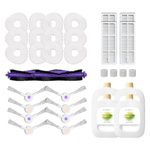Clean your robot vacuum once a week to keep it performing at its best — or more often if you have pets or high-traffic floors. While robot vacuums make cleaning effortless, they still need regular attention to stay efficient. This guide explains how often to clean your vacuum, why frequency matters, and how to adjust your schedule based on your home’s needs.
Why Cleaning Your Robot Vacuum Regularly Matters
Regular cleaning isn’t just about keeping your vacuum tidy — it’s what keeps it working like new. Over time, dust, hair, and debris can build up inside the brushes, filters, and sensors, quietly reducing cleaning power and efficiency.
-
Maintain strong suction power: When filters or brushes get clogged, suction drops and cleaning results suffer. Regular cleaning helps your robot pick up more dirt with every run.
-
Extend the lifespan of your device: Dust and tangled hair put extra strain on the motor and wheels, leading to wear and tear. A quick clean prevents these issues and helps your vacuum last longer.
-
Keep your home fresh and hygienic: Built-up debris can trap odors and bacteria. By cleaning your vacuum regularly, you ensure that it not only looks clean but also keeps your space healthier.
In short, the more consistently you clean your robot vacuum, the better it performs — and the less often you’ll need to replace or repair it.
Factors Affecting Cleaning Frequency
Several factors determine how often your robot vacuum should be cleaned.
-
Usage frequency: Daily use means more frequent cleaning is needed.
-
Living conditions: Homes with pets, kids, or heavy foot traffic will require cleaning more often due to increased dirt and debris.
-
Floor types: Hardwood, tile, and carpet all collect different types of dust and dirt. Hard floors tend to accumulate fine dust, while carpets trap pet hair. This affects the cleaning routine.
 How Often to Clean Your Robot Vacuum: A Simple Cleaning Schedule
How Often to Clean Your Robot Vacuum: A Simple Cleaning Schedule
Keeping your robot vacuum performing at its best is all about consistency. Here’s a simple guide to how often you should clean different parts of your vacuum — whether you run it daily or just a few times a week.
Daily Tasks (especially for pet owners or high-traffic homes)
Daily care prevents small issues from turning into bigger problems and keeps your vacuum running smoothly.
-
Empty the dustbin: If your vacuum doesn’t have a self-emptying feature, clear the bin every 2–3 days, or daily if you have pets. A full bin reduces suction power and overall cleaning efficiency.
-
Check wheels and sensors: Dust and hair can block sensors or wheels, affecting navigation and cleaning coverage. Gently wipe them down to ensure smooth movement and precise navigation.
Time needed: 2–3 minutes
Weekly Tasks (for all users)
A quick weekly check keeps your vacuum in peak shape and prevents dirt buildup.
-
Clean the main and side brushes: Remove hair and debris that collect around the brushes. This helps maintain strong suction and better dirt pickup — pet owners may need to do this twice a week.
-
Wipe charging contacts: Dirty charging points can cause inconsistent charging. Clean them with a dry cloth to ensure reliable battery performance.
Time needed: 5–10 minutes
Monthly Deep Check (optional but recommended)
A monthly deep clean ensures your vacuum continues to operate efficiently for the long term.
-
Clean or replace filters: Wash or replace the filter depending on your model. A clean filter improves suction and helps maintain indoor air quality.
-
Clean all sensors: Dust on sensors can cause navigation errors or missed spots. Wipe all sensors carefully, especially cliff or drop sensors.
-
Inspect for wear and tear: Check brushes, wheels, and filters for cracks or fraying. Replace any worn parts to keep your robot vacuum working like new.
Time needed: 10–15 minutes
Quick Summary
|
Frequency |
Task |
Time |
Notes |
|
Daily |
Empty dustbin; check wheels & sensors |
2–3 min |
Essential if pets or heavy traffic |
|
Weekly |
Clean brushes; wipe charging contacts |
5–10 min |
Maintains suction and efficiency |
|
Monthly |
Deep clean filters & sensors; inspect parts |
10–15 min |
Extends lifespan |
This schedule strikes the right balance between convenience and performance. If your home has pets or lots of activity, stick closer to the daily routine. For smaller or quieter households, a weekly routine is usually enough to keep your robot vacuum working efficiently and your floors spotless.
How Often Should You Clean It? Depends on Your Home.
Not every home needs the same cleaning routine. How often you should clean your robot vacuum depends on your household size, whether you have pets, and the kind of environment you live in. Here’s how to adjust your schedule to fit your lifestyle.
Household Size & Lifestyle
How big your home is — and how many people live in it — makes a big difference in how often you’ll need to clean your vacuum.
-
Small household or single resident: If you live alone or in a smaller space, cleaning your robot vacuum once a week is usually enough. Empty the dustbin, wipe the sensors, and check the brushes occasionally — simple upkeep will keep it running efficiently.
-
Large household or busy family: More people means more dust, crumbs, and foot traffic. For family homes, it’s best to empty the dustbin daily and give the brushes and wheels a quick check a few times a week to prevent buildup.
Tip: High-traffic areas like the kitchen or living room collect debris faster — consider increasing cleaning runs in these zones.
Pet Owners
If you have pets, your vacuum works overtime. Pet hair and dander can quickly clog brushes and filters, reducing suction power.
-
Homes with pets: Clean the vacuum at least once a week, paying special attention to brushes and filters.
-
Homes with heavy shedding pets: For long-haired pets, aim to empty the bin daily and clean the brushes every 2–3 days.
-
Running frequency: Use your robot vacuum daily or every other day to stay ahead of pet hair buildup — it’s easier to manage small amounts often than large messes later.
Tip: Keep an extra brush or filter set on hand for quick swaps — it saves time when hair clogs up the main parts.
Your Environment
Where you live also affects how often your robot vacuum needs attention.
-
Urban or dusty areas: City homes tend to collect more fine dust and allergens. Clean the filter and dustbin every few days to maintain air quality and suction power.
-
Seasonal conditions: During pollen season or sandy summer months, you may need to clean more often — about twice as much as your usual routine. This helps prevent clogs and ensures smooth operation.
Tip: If you notice reduced suction or more dirt left behind, it’s a sign your vacuum needs a quick clean — even outside your normal schedule.
Key Takeaway
Every home is different, but a simple rule applies:
The more people, pets, or dust you have, the more often you should clean your robot vacuum.
By adjusting your cleaning routine to your home’s conditions, you’ll keep your vacuum performing efficiently — and your floors spotless with less effort.
Strategies to Reduce Cleaning Frequency of Robot Vacuums
Invest in High-Performance Robot Vacuums
-
Self-Cleaning Features: Choose a robot vacuum equipped with self-cleaning or self-emptying capabilities. The Narwal Freo Z Ultra excels in this area, featuring an ultra-quiet base station that can self-empty its dustbin for up to 120 days, significantly minimizing the need for manual cleaning.
-
Smart Cleaning Adjustments: The Freo Z Ultra uses real-time AI to adjust its cleaning modes based on detected messes, ensuring efficient cleaning only when necessary.
[cta:narwal-freo-z-ultra-robot-vacuum-mop]
Optimize Your Cleaning Habits
-
Schedule Regular Cleaning: Utilize the app to set up scheduled cleaning tasks. The Narwal Freo Z Ultra allows users to program cleanings at convenient times, keeping floors tidy without requiring constant manual intervention.
-
Target High-Traffic Areas: Increase the cleaning frequency in high-traffic areas like kitchens and living rooms while reducing it in less-used spaces. The Freo Z Ultra’s advanced navigation technology ensures thorough cleaning in these critical areas.
Maintain and Care for Your Device
-
Make it a habit to inspect and clean the brushes, filters, and sensors regularly to keep your vacuum running at its best. The Narwal Freo Z Ultra features a certified zero-tangle brush, which minimizes hair tangling and reduces maintenance needs.
-
Use Quality Replacement Parts: Stick to original or compatible parts for your robot vacuum. The Narwal Freo Z Ultra is designed with high-quality components that enhance its longevity and performance.
Manage Your Environment Effectively
-
Minimize Floor Clutter: Before running the vacuum, clear the floor of obstacles such as cords and toys. This ensures the robot can move freely and finish cleaning without any disruptions.
-
Set No-Go Zones: Utilize the app to create no-go zones where the robot should not enter. This reduces unnecessary cleaning in areas that don’t require attention, improving overall efficiency.
Leverage Advanced Technology
Real-Time Monitoring and Feedback: The Narwal Freo Z Ultra features dual RGB cameras and AI chips that allow it to monitor floor cleanliness in real-time. This capability helps decrease unnecessary cleaning cycles while maintaining a clean environment.
By incorporating these strategies and considering the Narwal Freo Z Ultra, users can effectively reduce the frequency of manual cleanings while ensuring their homes remain clean and hygienic. Its unique features make it an excellent option for those seeking an easier, more efficient cleaning experience.
Conclusion
Consistent cleaning is essential for maintaining your robot vacuum's peak performance. By sticking to a routine of daily, weekly, and monthly maintenance, you ensure it works efficiently for longer. Adapt the cleaning schedule to suit your home, and take advantage of smart features like scheduling and maintenance reminders to make it even easier. Don't wait—take action today to keep your robot vacuum running smoothly and your home spotless with minimal effort.






















